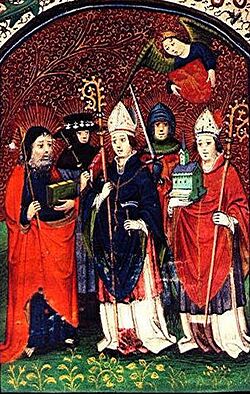Saint Ghislain facts for kids
Quick facts for kids SaintGhislain |
|
|---|---|

Dutch Book of Prayers from the mid-fifteenth century. Ghislain is the figure on the far right, holding a church.
|
|
| Died | 9 October 680 |
| Venerated in | |
| Feast | 9 October |
| Attributes | represented with a bear or bear's cub beside him |
| Patronage | invoked against convulsions from children |
Ghislain (who died on October 9, 680) was a very religious man who lived a quiet life dedicated to his faith in Belgium. He is remembered for living as a hermit (someone who lives alone for religious reasons) and helping others. He passed away in the town that is now named after him, Saint-Ghislain.
Contents
Who Was Saint Ghislain?
Ghislain likely came from a Germanic background. He lived in a region called Hainaut (pronounced Hay-no) during the time of other important religious figures. These included Amandus (who died in 679), Waltrude, Aldegonde, and Amalberga of Maubeuge.
Starting a New Life
Ghislain, along with two students named Lambert and Berler, cleared a piece of land near a place called Castrilocus. This area is now known as Mons in Hainaut. Later, he moved to a spot called Ursidongus. Here, he built a small chapel dedicated to Peter and Paul the Apostle.
Meeting Important People
A religious leader named Aubert of Avranches wanted to meet Ghislain. He wanted to understand the hermit's intentions. After their meeting, Aubert gave Ghislain strong support.
During a visit to Cambrai, Ghislain spent some time in a large house in Roisin. He received gifts of land in Celles and Hornu. He soon became friends with Waltrude. She was inspired by him to build a monastery in Castrilocus, where Ghislain had first lived.
Helping Other Saints
It is believed that Ghislain also influenced the religious path of Aldegonde, who became an Abbess (head of a monastery for women) in Maubeuge. He also influenced Amalberga and Aldetrude, who were Waltrude's daughters.
One day, Aldegonde had a vision in her monastery. Her biographer said it showed the death of Amandus, a Bishop. Ghislain visited her and explained that the vision was actually a sign of her own death coming soon.
Ghislain and Aldegonde's friendship led to a strong connection between the monasteries in Maubeuge and Ursidongus. Waltrude rewarded Ghislain by giving him part of the land in Frameries and a chapel in Saint-Quentin.
Remembering Saint Ghislain
Ghislain died in Ursidongus. The monastery he had started there was later named after him: Saint-Ghislain Abbey.
His Relics and Feast Day
The remains of Saint Ghislain were first moved around the year 929. They were later moved to Grandlieu, near Quaregnon, around the late 900s or early 1000s. In 1025, Gerard of Florennes, who was the Bishop of Cambrai, moved them to Le Cateau-Cambrésis. Bishops from Cambrai visited them many times during the Middle Ages.
In 1647, his remains were moved to the town of Saint-Ghislain. He is considered the patron saint of this town. His feast day is celebrated every year on October 9. People often pray to him to help protect children from convulsions (sudden, uncontrolled movements) and epilepsy (a condition that causes seizures). In the old church of St. Martin in Saint-Ghislain, there was once an altar dedicated to him. Children suffering from epilepsy were brought there, hoping for a cure.
Symbols of Saint Ghislain
In art, Saint Ghislain is often shown with a bear or a bear cub next to him. This comes from a popular story. The legend says that a bear, being chased by King Dagobert I, found safety with Ghislain. The bear then showed Ghislain the perfect spot to build his monastery. Also, the place where Ghislain lived was called Ursidongus, which means "bear's den."
There is a street named Rue Saint-Ghislain/Sint-Gissleinsstraat in Brussels, Belgium.
Images for kids
See also
- List of Catholic saints


